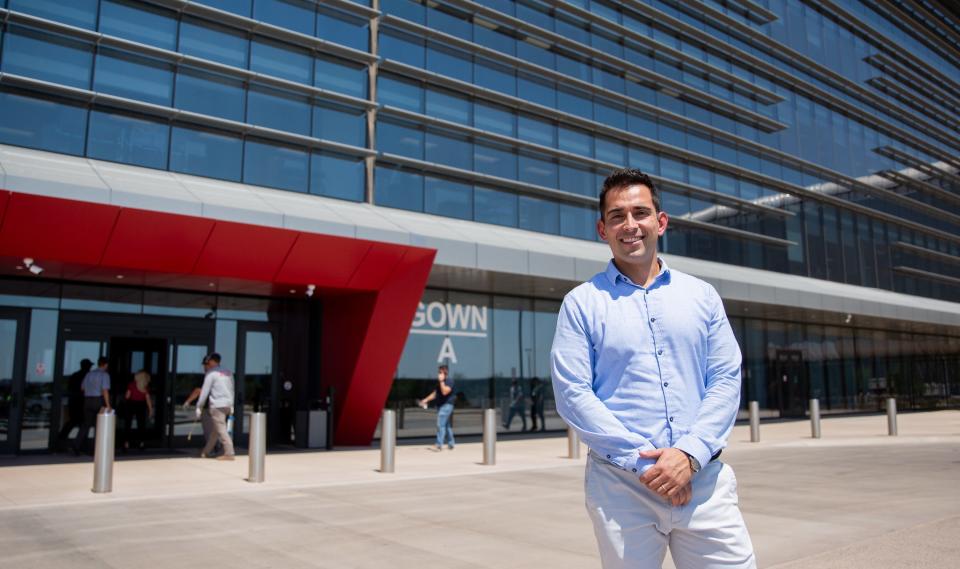Where have all the workers gone? Big employers aren't adding jobs, even if they want to
Corrections & Clarifications: The U.S. labor participation rate was as high as 67% in 2000. A previous version of the article listed an incorrect year.
The recent advent of AI, or artificial intelligence, has made a lot of people worry about losing their jobs. But the way employment is trending, we might need help from this new area of innovation simply to keep the economy running.
Job losses really aren’t the problem right now. Hiring and retention are. This has become evident among Arizona’s largest employers, who are struggling just to keep their payrolls intact amid a steady wave of retirements, resignations, reshufflings and career reinventions.
The 100 largest nongovernmental employers surveyed by The Arizona Republic this summer reported virtually no net change in jobs compared with a year earlier. The cumulative total of 608,800 is up a mere 0.1% from 607,900 this time last year. The top 100 employers, including a few large nonprofits, account for about one in six statewide jobs.
The pattern also is showing up on the broader employment landscape, which includes government employers, tens of thousands of small businesses and gig workers. While Arizona’s total employment has risen a more respectable 1.8% over the past year, that’s still down from an average annual 2.3% over the past decade.
“The weaker hiring this summer is a sign that growth within Arizona is slowing in response to high interest rates and higher costs for employers,” wrote Nationwide’s senior economist, Ben Ayers, in response to a July employment report that showed only 14,000 new jobs created over the past six months.
But there are more factors at play than just higher interest rates and costs. Tens of thousands of Arizonans, and millions of Americans, no longer want to work and have decided they can afford to stop.
Who's really participating in the workforce?
The nation’s labor participation rate, which reflects the percentage of nonretired, noninstitutionalized adults who are employed or looking for work, has ebbed to 62.8% from 67% in 2000. In Arizona, the rate is even lower, 61.8%. In other words, for roughly every three able-bodied and available individuals below traditional retirement age who are working or looking, two others aren’t.
Arizona had 193,000 job openings in June, the most recent month tracked by the federal Bureau of Labor Statistics. That same month, 122,000 people here were hired but even more, 130,000 individuals, left their employment. Most of the latter were voluntary separations, including 93,000 people who quit — nearly three times the number who were laid off or fired.
The elevated rate of quitting reflects confidence among workers that they will be able to land a new position if they leave, said Travis Laird, senior regional vice president at staffing and consulting firm Robert Half.
Arizona’s unemployment rate, at 3.6% in July, has barely budged from 3.3% one year earlier.
No wonder many employers grasp at qualified applicants when they come their way. Dr. Victor Ortega said Mayo Clinic created a special position for him when he applied for another opening. That perhaps isn’t surprising given Ortega’s expertise in pulmonary disease treatment and genetic research, but he was impressed by the organization’s flexibility.

Ortega, who was born in Puerto Rico and lived most recently in North Carolina, focuses his research on underrepresented populations, especially communities of color. Puerto Ricans, for example, are some of the worst asthma sufferers, he said, along with other Latinos, African Americans and Native Americans. Still, genomic research on these groups has lagged.
Ortega said he appreciates Mayo’s ability to support his research while also making it possible for him to continue seeing patients, including acute asthma sufferers, many of whom travel here from other states. “They really bring doctors together for the patient,” said Ortega, who works both at Mayo’s Phoenix and Scottsdale campuses. “Many of those patients need a lot of attention.”
Mayo showed some of the most impressive job gains over the last year, adding more than 1,000 employees. Other notable gainers in the hospital and health sector include Banner Health, again the state’s overall employment leader, along with HonorHealth, Phoenix Children’s and TMC Health, which operates Tucson Medical Center.
Opportunities for nontraditional workers
The widespread availability of jobs allows more nontraditional workers to seek and find employment. Rhonda Benston Showman, who has worked as a bartender in downtown Phoenix since the 1970s, decided to retire when the COVID-19 pandemic hit in 2020. But her exit from the workforce didn’t last long.
“I stayed home for a couple of months but told my husband this wasn’t for me,” said Showman, 74. She came out of retirement and now works four days a week at the Marriott’s Renaissance Phoenix Downtown Hotel. “I like to be around people,” she said.
Her day shift starts at 9 a.m. cutting fruit and making other preparations for the 16 chairs she oversees, and her shift ends around 5 p.m. “Every day is different” and so are the visitors, she said, based largely on what’s happening at the nearby Phoenix Convention Center and sporting venues Footprint Center and Chase Field.

“I want to take care of guests and make them feel welcome when they come to the hotel,” she said.
Showman, who started working at the bar in 1975 when it was the Adams Hotel and continued there under several ownership changes, figures she has made pretty much every drink over the decades. Manhattan Old Fashioned cocktails are making a comeback now, she added.
Her enthusiasm paid off with a major honor from Marriott, which this year named her one of 10 global winners of a companywide award of excellence that recognizes achievement, character, dedication, effort and perseverance.
The impact of retirement and the pandemic
Demographers knew for decades that the pool of available workers would shrink as more baby boomers started to retire. What they didn’t plan on was the COVID-19 pandemic, which distorted the job market.
“In 2022, employers added an unprecedented 4.5 million jobs,” wrote Stephanie Ferguson, director of global employment policy at the U.S. Chamber of Commerce, in a new study. “But at the same time, millions of Americans have been leaving the labor force.”
In a survey of former workers, the chamber found that 28% were staying home because of their own illness or to provide health care for a partner. That’s in addition to 27% staying home to care for kids or other family members, partly because care has been more difficult to find. The percentage of working mothers in the labor force has dropped from 70% in 2020 to 55% today, according to the chamber. All told, there are now 2 million fewer participants in the labor force compared with February 2020, at the onset of the COVID-19 pandemic.
In addition, some people have stayed in the labor force but no longer are working for traditional employers, Ferguson’s report added. For example, budding entrepreneurs filed 10 million new business applications over the past two years. Thanks to unemployment benefits, stimulus checks and other assistance, along with rising personal savings for many, millions of Americans have felt they can stop working or try something new, like starting their own business. Reduced foreign immigration has been another factor keeping the labor pool down, according to the Chamber of Commerce report.
Banner and Walmart lead, Amazon falls back
Most of Arizona’s top employers have been reporting job totals similar to where they were a year ago. One notable change was a decrease for Amazon.com from 40,000 a year ago to 33,000 more recently. Spokespeople for the company didn’t provide an explanation for the decrease, which pushed the giant online retailer from second place to third in Arizona, behind Banner Health and Walmart. But Amazon’s global employment also has been dropping, down 4% at the start of 2023 from the start of 2022.
The job numbers in The Republic's report on largest nongovernmental employers are mostly self-reported. They were collected in July and August. Most employers cooperated, but some companies and nonprofit groups declined requests to disclose their Arizona workforce totals. In these cases, The Republic estimated their statewide employment counts using other available information, such as national job totals reported by public corporations in annual reports.
Sometimes the numbers bounce around as companies report employment differently from one year to the next — for example, by adding or subtracting part-time workers or adding or subtracting those working for franchisees.
At a time when qualified workers are harder to find, it's no surprise that pay has been rising, too, though not dramatically. The median annual salary for Arizona workers who stayed in their roles for at least 12 months stood at $52,000 in July, up 7% over the prior year, according to human-resources company ADP. Nationally, annual pay was up 6.2% over the same period to $57,600.
Annual wage growth in the range of 3% to 4% has been more typical of Arizona historically, Laird added.
Of the roughly 3.53 million employed Arizonans, 75% work in the Phoenix area. The state’s largest nongovernmental employers are concentrated even more heavily here. Defense contractor Raytheon/RTX, with a large operation in Tucson, is among the exceptions.
Cracking the top 100

Among the newcomers to this year’s Republic 100 are Taiwan Semiconductor Manufacturing Co., PayPal Holdings and Insight Enterprises. TSMC, in particular, has garnered attention as the Taiwan-based chip-manufacturing giant continues to build out a massive manufacturing complex in northwest Phoenix.
Mino Morgese, who joined the company nearly two years ago, said two key factors really excited him about TSMC. One was the company’s dominance in cutting-edge semiconductors, the tiny brains that help control an increasingly broad array of computers, cellphones, autos, weapon systems and everyday consumer items.
He’s a senior manager who oversees a staff of 60 installing intricate, expensive machinery at the Phoenix plant. “We’re putting in the water, gas, chemical and other lines and connecting them to the equipment,” he said. “It’s not as simple as installing a pipe.”
Morgese spends about half of a typical week in the ultra pure “clean rooms,” where he dons the ultra-hygenic garments known as bunny suits. Machinery installation will continue for a while at the Phoenix complex, he said, followed by ongoing maintenance.
The second main factor that drew him to TSMC was the diversity aspect. Building and equipping a semiconductor factory or “fab” is hard enough, and the many different types of people working at the new plant, including Americans, Taiwanese and other nationalities, added to the intrigue. “We’re bringing all of these different cultures together under one roof,” he said.
Morgese, 39, is an example of that. Born in Italy, he earned his undergraduate electrical engineering degree at the University of Utah, a master's degree at Arizona State University, trained for a year at TSMC facilities in Taiwan and now lives and works in metro Phoenix.
More tech-related positions
Semiconductor jobs, while growing, still represent a fairly small slice of overall employment for the 100 largest companies and nonprofit groups in Arizona. But employers in many other fields, including aerospace, manufacturing and finance, rely heavily on what's produced.
Another Arizona employer that added staff over the past year is Achieve, a digital personal-finance company formerly known as Freedom Financial. With a campus on the south shore of Tempe Town Lake, the company employs 2,092 people in Arizona, up from about 2,000 this time last year. Achieve helps people manage debt and obtain loans. Money issues pose a huge challenge for millions of Americans, especially with credit card interest rates rising and student-loan forbearance ending.
That's one aspect that attracted Jean Shapiro, who in June was hired as the company's chief security officer. She supervises a staff of around 28 analysts, engineers and others, and she spends a lot of time communicating with vendors, peer organizations and others about ransomware and additional cyberthreats.

"My job is to keep our systems and data safe," she said. "Anything IT-related is part of my job."
That includes artificial intelligence, which Achieve has started to use for internal help-desk assistance. Shapiro thinks AI also has the potential to improve services for customers, of whom Achieve counts about 400,000 nationally. But she said it won't replace the "human touch" in coaching and empathizing with customers, many of whom at Achieve are dealing with the stress that financial troubles can bring.
Losing ground: General Motors to close Chandler innovation hub, lay off 936 workers
Artificial intelligence: Good or bad?
Given the current hiring and retention difficulties faced by many businesses, it’s worth noting the potential for artificial intelligence applications to replace some workers or fill lingering vacancies.
More than 300,000 jobs by 2027 in metro Phoenix alone could be threatened or filled by AI (depending on how you look at it), according to a study by Chamber of Commerce, a small-business research entity not affiliated with the U.S. Chamber of Commerce. Of these, about 60% of the job losses or replacements will likely involve positions in retail sales and customer service as well as cashiers, according to the study, which also sees bookkeepers, accountants, factory workers, security staff and other vocations affected.
AI, especially generative AI, involves computer-generated text messages and images. Some versions allow for humanlike voice conversations.
Not everyone likes this. For example, the federal Consumer Financial Protection Bureau said it has received numerous complaints from banking consumers frustrated with having to deal with AI-generated chatbots rather than live customer service representatives. Banks are stepping up their use to reduce staffing expenses, the agency said.
While AI has the potential to eliminate millions of jobs, there’s an upside potential, too. Of 2,500 U.S. employees surveyed in May by Robert Half, 41% of respondents said they envision a positive impact on their careers compared with 14% expecting negative fallout (with most of the rest not seeing much impact or not sure how to respond).
AI software has the potential to automate time-consuming tasks and increase efficiency and productivity, many respondents said. Among the more specific potential benefits cited are the ability of AI to automate data entry, write job descriptions, analyze customer feedback, streamline documents for review and write copy for advertising and social media campaigns.
Laird sees AI less as a threat to jobs and more as a way to reshape them. He considers it another step in a long line of productivity-enhancing automation tools that have included fax machines, centralized voice-messaging systems, computers and more.
While many employers are still figuring out how to use AI, the technology holds promise as a way to outsource routine tasks in the workplace. "It will open up new opportunities to make people more efficient," he predicted.
Reach the writer at russ.wiles@arizonarepublic.com.
This article originally appeared on Arizona Republic: Arizona's big employers aren't adding jobs, even if they want to
